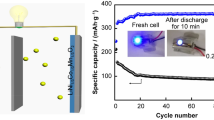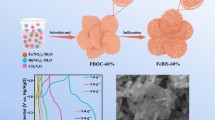Abstract
The low capacity and rate capability of the battery-type supercapacitor anode prevent its widespread application. In this paper, we construct a semicoherent heterojunction of Fe2O3/FeSe2 as an advanced battery-type supercapacitor anode to overcome the bottleneck. A series of characterization and first-principles calculations confirm that the special heterointerface manipulation automatically generates a stronger inherent electric field, thereby enhancing the electron transport rate and the OH− adsorption capacity. In addition, it facilitates additional redox reactions between the active materials and OH− and makes the reaction system easier to execute. Taking advantage of these benefits, the prepared anode has a high specific capacity of 199.2 mA h g−1 (1 A g−1) and retains 90.2% of its initial capacity after 5000 cycles at 105.8 mA h g−1 (10 A g−1). In addition, an asymmetric supercapacitor device is fabricated with the prepared Fe2O3/FeSe2 as the anode, which provides a maximum energy density of 52.55 W h kg−1 at 0.8 kW kg−1 and a capacity retention of 91.2% even after 15,000 cycles. In our work, a novel strategy for the optimal design of a battery-type supercapacitor anode with a large capacity and superior rate capability is conceived, significantly advancing the widespread application of transition metal compounds in energy storage systems.

摘要
低容量和低倍率限制了电池型超级电容阳极材料的大规模应用.本文通过构建一种具有半共格异质界面特性的Fe2O3/FeSe 2 纳米结构作为先进的阳极材料来解决这一瓶颈. 系列表征和第一性原理计算表明,这种特殊的异质界面不仅能自发产生较强的内建电场, 从而提高电子传递速率和OH−离子的吸附能力; 还可使得活性物质与OH−之间发生更多的氧化还原反应, 并且使该反应体系更容易进行. 基于上述优势,所制备出的阳极材料的最大比容量为199.2 mA h g−1(1 A g−1), 并且在10 A g−1下仍能保持105.8 mA h g−1, 同时, 经历5000次循环后, 其比容量可维持初始值的90.2%. 此外, 以Fe2O3/FeSe2作为阳极组装的非对称超级电容器在0.8 kW kg−1时的能量密度为52.55 W h kg−1, 即使经历15,000次循环, 该器件还能维持初始容量的91.2%. 我们的工作为设计大容量和高倍率性能的电池型超级电容器阳极材料提供了一种创新性的策略, 有望推动过渡金属化合物在储能系统中的大规模应用.
Similar content being viewed by others
References
Sheberla D, Bachman JC, Elias JS, et al. Conductive MOF electrodes for stable supercapacitors with high areal capacitance. Nat Mater, 2017, 16: 220–224
Shao Y, El-Kady MF, Sun J, et al. Design and mechanisms of asymmetric supercapacitors. Chem Rev, 2018, 118: 9233–9280
Choudhary N, Li C, Moore J, et al. Asymmetric supercapacitor electrodes and devices. Adv Mater, 2017, 29: 1605336
Salanne M, Rotenberg B, Naoi K, et al. Efficient storage mechanisms for building better supercapacitors. Nat Energy, 2016, 1: 16070
Urbain F, Smirnov V, Becker JP, et al. Multifunction Si photocathodes with tunable photovoltages from 2.0 V to 2.8 V for light induced water splitting. Energy Environ Sci, 2016, 9: 145–154
Sun H, Mei L, Liang J, et al. Three-dimensional holey-graphene/niobia composite architectures for ultrahigh-rate energy storage. Science, 2017, 356: 599–604
Li S, Sharma N, Yu C, et al. Operando tailoring of defects and strains in corrugated β-Ni(OH)2 nanosheets for stable and high-rate energy storage. Adv Mater, 2021, 33: 2006147
Zhao Y, Liu J, Horn M, et al. Recent advancements in metal organic framework based electrodes for supercapacitors. Sci China Mater, 2018, 61: 159–184
Wechsler SC, Amir FZ. Superior electrochemical performance of pristine nickel hexaaminobenzene MOF supercapacitors fabricated by electrophoretic deposition. ChemSusChem, 2020, 13: 1491–1495
Du R, Wu Y, Yang Y, et al. Porosity engineering of MOF-based materials for electrochemical energy storage. Adv Energy Mater, 2021, 11: 2100154
Yang B, Li B, Xiang Z. Advanced MOF-based electrode materials for supercapacitors and electrocatalytic oxygen reduction. Nano Res, 2023, 16: 1338–1361
Yang W, Shi X, Li Y, et al. Manganese-doped cobalt zeolitic imidazolate framework with highly enhanced performance for supercapacitor. J Energy Storage, 2019, 26: 101018
Nagaraju G, Sekhar SC, Yu JS. Utilizing waste cable wires for high-performance fiber-based hybrid supercapacitors: An effective approach to electronic-waste management. Adv Energy Mater, 2018, 8: 1702201
Dong L, Ma X, Li Y, et al. Extremely safe, high-rate and ultralong-life zinc-ion hybrid supercapacitors. Energy Storage Mater, 2018, 13: 96–102
Zuo X, Chang K, Zhao J, et al. Bubble-template-assisted synthesis of hollow fullerene-like MoS2 nanocages as a lithium ion battery anode material. J Mater Chem A, 2016, 4: 51–58
Zan G, Wu T, Hu P, et al. An approaching-theoretical-capacity anode material for aqueous battery: Hollow hexagonal prism Bi2O3 assembled by nanoparticles. Energy Storage Mater, 2020, 28: 82–90
Zheng Z, Zao Y, Zhang Q, et al. Robust erythrocyte-like Fe2O3@carbon with yolk-shell structures as high-performance anode for lithium ion batteries. Chem Eng J, 2018, 347: 563–573
Ge P, Hou H, Li S, et al. Tailoring rod-like FeSe2 coated with nitrogen-doped carbon for high-performance sodium storage. Adv Funct Mater, 2018, 28: 1801765
Deng Y, Liu Z, Wang A, et al. Oxygen-incorporated MoX (X: S, Se or P) nanosheets via universal and controlled electrochemical anodic activation for enhanced hydrogen evolution activity. Nano Energy, 2019, 62: 338–347
Zhao J, Li Z, Yuan X, et al. A high-energy density asymmetric supercapacitor based on Fe2O3 nanoneedle arrays and NiCo2O4/Ni(OH)2 hybrid nanosheet arrays grown on SiC nanowire networks as freestanding advanced electrodes. Adv Energy Mater, 2018, 8: 1702787
Pan Q, Zhang M, Zhang L, et al. FeSe2@C microrods as a superior longlife and high-rate anode for sodium ion batteries. ACS Nano, 2020, 14: 17683–17692
Tang X, Jia R, Zhai T, et al. Hierarchical Fe3O4@Fe2O3 core-shell nanorod arrays as high-performance anodes for asymmetric supercapacitors. ACS Appl Mater Interfaces, 2015, 7: 27518–27525
Dai S, Bai Y, Shen W, et al. Core-shell structured Fe2O3@Fe3C@C nanochains and Ni-Co carbonate hydroxide hybridized microspheres for high-performance battery-type supercapacitor. J Power Sources, 2021, 482: 228915
Xia H, Hong C, Li B, et al. Facile synthesis of hematite quantum-dot/functionalized graphene-sheet composites as advanced anode materials for asymmetric supercapacitors. Adv Funct Mater, 2015, 25: 627–635
Ge J, Wang B, Wang J, et al. Nature of FeSe2/N-C anode for high performance potassium ion hybrid capacitor. Adv Energy Mater, 2020, 10: 1903277
Li S, Zang W, Liu X, et al. Heterojunction engineering of MoSe2/MoS2 with electronic modulation towards synergetic hydrogen evolution reaction and supercapacitance performance. Chem Eng J, 2019, 359: 1419–1426
Lin Y, Sun K, Liu S, et al. Construction of CoP/NiCoP nanotadpoles heterojunction interface for wide pH hydrogen evolution electrocatalysis and supercapacitor. Adv Energy Mater, 2019, 9: 1901213
Wang X, Liu Y, Li H, et al. Regulating the self-discharge of flexible all-solid-state supercapacitors by a heterogeneous polymer electrolyte. Small, 2021, 17: 2102054
Shen J, Wu J, Pei L, et al. CoNi2S4-graphene-2D-MoSe2 as an advanced electrode material for supercapacitors. Adv Energy Mater, 2016, 6: 1600341
Chen L, Huang J, Zeng R, et al. Regulating voltage window and energy density of aqueous asymmetric supercapacitors by pinecone-like hollow Fe2O3/MnO2 nano-heterostructure. Adv Mater Interfaces, 2020, 7: 1901729
Pesci FM, Sokolikova MS, Grotta C, et al. MoS2/WS2 heterojunction for photoelectrochemical water oxidation. ACS Catal, 2017, 7: 4990–4998
Yao K, Xu Z, Ma M, et al. Densified metallic MoS2/graphene enabling fast potassium-ion storage with superior gravimetric and volumetric capacities. Adv Funct Mater, 2020, 30: 2004244
Shan H, Qin J, Ding Y, et al. Controllable heterojunctions with a semicoherent phase boundary boosting the potassium storage of CoSe2/FeSe2. Adv Mater, 2021, 33: 2102471
Huang H, Zhao J, Du Y, et al. Direct Z-scheme heterojunction of semicoherent FAPbBr3/Bi2WO6 interface for photoredox reaction with large driving force. ACS Nano, 2020, 14: 16689–16697
Lu X, Zeng Y, Yu M, et al. Oxygen-deficient hematite nanorods as high-performance and novel negative electrodes for flexible asymmetric supercapacitors. Adv Mater, 2014, 26: 3148–3155
An C, Yuan Y, Zhang B, et al. Graphene wrapped FeSe2 nano-micro-spheres with high pseudocapacitive contribution for enhanced Na-ion storage. Adv Energy Mater, 2019, 9: 1900356
Shi W, Zhang X, Che G, et al. Controlled hydrothermal synthesis and magnetic properties of three-dimensional FeSe2 rod clusters and microspheres. Chem Eng J, 2013, 215–216: 508–516
Peng Q, Zhao H, Qian L, et al. Design of a neutral photo-electro-Fenton system with 3D-ordered macroporous Fe2O3/carbon aerogel cathode: High activity and low energy consumption. Appl Catal B-Environ, 2015, 174–175: 157–166
Wang H, Wang X, Li Q, et al. Constructing three-dimensional porous carbon framework embedded with FeSe2 nanoparticles as an anode material for rechargeable batteries. ACS Appl Mater Interfaces, 2018, 10: 38862–38871
Bhattacharya P, Kota M, Suh DH, et al. Biomimetic spider-web-like composites for enhanced rate capability and cycle life of lithium ion battery anodes. Adv Energy Mater, 2017, 7: 1700331
Li Y, Xu J, Feng T, et al. Fe2O3 nanoneedles on ultrafine nickel nanotube arrays as efficient anode for high-performance asymmetric supercapacitors. Adv Funct Mater, 2017, 27: 1606728
Tang Q, Wang W, Wang G. The perfect matching between the low-cost Fe2O3 nanowire anode and the NiO nanoflake cathode significantly enhances the energy density of asymmetric supercapacitors. J Mater Chem A, 2015, 3: 6662–6670
Liu WW, Feng YQ, Yan XB, et al. Superior micro-supercapacitors based on graphene quantum dots. Adv Funct Mater, 2013, 23: 4111–4122
Han Y, Sun C, Gao K, et al. Heterovalent oxynitride GaZnON nanowire as novel flexible anode for lithium-ion storage. Electrochim Acta, 2022, 408: 139931
Tan C, Luo Z, Chaturvedi A, et al. Preparation of high-percentage 1T-phase transition metal dichalcogenide nanodots for electrochemical hydrogen evolution. Adv Mater, 2018, 30: 1705509
Brezesinski T, Wang J, Tolbert SH, et al. Ordered mesoporous α-MoO3 with iso-oriented nanocrystalline walls for thin-film pseudocapacitors. Nat Mater, 2010, 9: 146–151
Meng A, Yuan X, Shen T, et al. One-step synthesis of flower-like Bi2O3/Bi2Se3 nanoarchitectures and NiCoSe2/Ni0.85Se nanoparticles with appealing rate capability for the construction of high-energy and long-cycle-life asymmetric aqueous batteries. J Mater Chem A, 2019, 7: 17613–17625
Zhao X, Sajjad M, Zheng Y, et al. Covalent organic framework templated ordered nanoporous C60 as stable energy efficient supercapacitor electrode material. Carbon, 2021, 182: 144–154
Hussain I, Mohapatra D, Dhakal G, et al. Different controlled nanostructures of Mn-doped ZnS for high-performance supercapacitor applications J Energy Storage, 2020, 32: 101767
Li Y, An F, Wu H, et al. A NiCo2S4/hierarchical porous carbon for high performance asymmetrical supercapacitor. J Power Sources, 2019, 427: 138–144
Vamsi Krishna BN, Khaja Hussain S, Yu JS. Three-dimensional flowerlike nickel doped cobalt phosphate hydrate microarchitectures for asymmetric supercapacitors. J Colloid Interface Sci, 2021, 592: 145–155
Asaithambi S, Sakthivel P, Karuppaiah M, et al. Preparation of FeSnO2@CeO2 nanocomposite electrode for asymmetric supercapacitor device performance analysis. J Energy Storage, 2021, 36: 102402
Zhang M, Li Y, Shen Z. “Water-in-salt” electrolyte enhanced high voltage aqueous supercapacitor with all-pseudocapacitive metal-oxide electrodes. J Power Sources, 2019, 414: 479–485
Acknowledgements
This work was supported by the National Natural Science Foundation of China (52072196, 52002199, 52002200, and 52102106), the Major Basic Research Program of Natural Science Foundation of Shandong Province (ZR2020ZD09), the Natural Science Foundation of Shandong Province (ZR2019BEM042 and ZR2020QE063), the Innovation and Technology Program of Shandong Province (2020KJA004), Taishan Scholars Program of Shandong Province (ts201511034), and the Postdoctoral Innovation Project of Shandong Province (202101020).
Author information
Authors and Affiliations
Contributions
Song J conducted the experiment and analyzed the experimental data. Liu T and He Y analyzed part of the experimental data. Wang Y, Zhang Y and Yuan X performed the characterizations. Meng A, Wang L and Li G performed some data analysis and offered helpful suggestion. Zhao J and Li Z designed the project and the experiments. Song J wrote the paper with support from Zhao J and Li Z. All authors contributed to the general discussion.
Corresponding authors
Additional information
Conflict of interest
The authors declare that they have no conflict of interest.
Supplementary information
Supporting data are available in the online version of the paper.
Jiangnan Song is a Master’s candidate at the College of Electromechanical Engineering, Qingdao University of Science & Technology. His current research focuses on supercapacitor synthesis, characterization, and electrochemical performance.
Jian Zhao received his PhD degree from Qingdao University of Science & Technology in 2017. His research interests include the synthesis, characterization, electrochemical performances, and mechanism of supercapacitor electrode materials.
Zhenjiang Li is a professor at the College of Sino-German Science and Technology, Qingdao University of Science & Technology. He received his PhD degree in nanomaterials from the Northwestern Polytechnical University in 2003. His current research focuses on the synthesis and application of 1D nanomaterials with high performance for energy storage and conversion.
Electronic Supplementary Material
40843_2022_2330_MOESM1_ESM.pdf
Engineering semicoherent interface with O–Fe–Se coordination for boosting the capacity and rate capability of a battery-type supercapacitor anode
Rights and permissions
About this article
Cite this article
Song, J., Liu, T., He, Y. et al. Engineering semicoherent interface with O–Fe–Se coordination for boosting the capacity and rate capability of a battery-type supercapacitor anode. Sci. China Mater. 66, 1767–1778 (2023). https://doi.org/10.1007/s40843-022-2330-6
Received:
Accepted:
Published:
Issue Date:
DOI: https://doi.org/10.1007/s40843-022-2330-6




